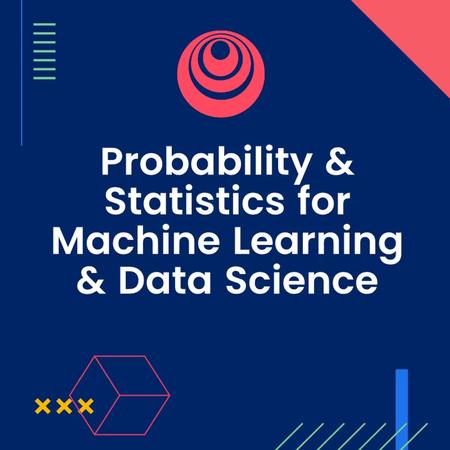English | MP4 | AVC 1280×720 | AAC 44KHz 2ch | 206 Lessons (14h 46m) | 1.62 GB
Master the Toolkit of AI and Machine Learning. Mathematics for Machine Learning and Data Science is a beginner-friendly Specialization where you’ll learn the fundamental mathematics toolkit of machine learning: calculus, linear algebra, statistics, and probability.
Mathematics for Machine Learning and Data Science is a foundational online program created by DeepLearning.AI and taught by Luis Serrano. This beginner-friendly Specialization is where you’ll master the fundamental mathematics toolkit of machine learning.
Many machine learning engineers and data scientists need help with mathematics, and even experienced practitioners can feel held back by a lack of math skills. This Specialization uses innovative pedagogy in mathematics to help you learn quickly and intuitively, with courses that use easy-to-follow plugins and visualizations to help you see how the math behind machine learning actually works.
This is a beginner-friendly program, with a recommended background of at least high school mathematics. We also recommend a basic familiarity with Python, as labs use Python to demonstrate learning objectives in the environment where they’re most applicable to machine learning and data science.
What you’ll learn
- A deep understanding of the math that makes machine learning algorithms work.
- Statistical techniques that empower you to get more out of your data analysis.
- Fundamental skills that employers desire, helping you ace machine learning interview questions and land your dream job.
- Represent data as vectors and matrices and identify their properties using concepts of singularity, rank, and linear independence
Table of Contents
machine-learning-calculus
week-1-derivatives-and-optimization
lesson-1-derivatives
course-introduction
machine-learning-motivation
motivation-to-derivatives-part-i
derivatives-and-tangents
slopes-maxima-and-minima
approximation-of-derivatives_instructions
derivatives-and-their-notation
some-common-derivatives-lines
some-common-derivatives-quadratics
some-common-derivatives-higher-degree-polynomials
some-common-derivatives-other-power-functions
the-inverse-function-and-its-derivative
derivative-of-trigonometric-functions
meaning-of-the-exponential-e
the-derivative-of-e-x
the-derivative-of-log-x
existence-of-the-derivative
properties-of-the-derivative-multiplication-by-scalars
properties-of-the-derivative-the-sum-rule
properties-of-the-derivative-the-product-rule
properties-of-the-derivative-the-chain-rule
ungraded-lab
optional-downloading-your-notebook-and-refreshing-your-workspace_instructions
lesson-2-optimization
introduction-to-optimization
optimization-of-squared-loss-the-one-powerline-problem
optimization-of-squared-loss-the-two-powerline-problem
optimization-of-squared-loss-the-three-powerline-problem
optimization-of-log-loss-part-1
optimization-of-log-loss-part-2
week-1-conclusion
programming-assignment-optimizing-functions-of-one-variable-cost-minimization
optional-assignment-troubleshooting-tips_instructions
optional-partial-grading-for-assignments_instructions
lecture-notes
week-1-slides_instructions
week-2-gradients-and-gradient-descent
lesson-1-gradients
introduction-to-tangent-planes
partial-derivatives-part-1
partial-derivatives-part-2
gradients
gradients-and-maxima-minima
optimization-with-gradients-an-example
optimization-using-gradients-analytical-method
lesson-2-gradient-descent
optimization-using-gradient-descent-in-one-variable-part-1
optimization-using-gradient-descent-in-one-variable-part-2
optimization-using-gradient-descent-in-one-variable-part-3
optimization-using-gradient-descent-in-two-variables-part-1
optimization-using-gradient-descent-in-two-variables-part-2
optimization-using-gradient-descent-least-squares
optimization-using-gradient-descent-least-squares-with-multiple-observations
week-2-conclusion
lecture-notes
week-2-slides_instructions
week-3-optimization-in-neural-networks-and-newtons-method
lesson-1-optimization-in-neural-networks
regression-with-a-perceptron
regression-with-a-perceptron-loss-function
regression-with-a-perceptron-gradient-descent
classification-with-perceptron
classification-with-perceptron-the-sigmoid-function
classification-with-perceptron-gradient-descent
classification-with-perceptron-calculating-the-derivatives
classification-with-a-neural-network
classification-with-a-neural-network-minimizing-log-loss
gradient-descent-and-backpropagation
lesson-2-newtons-method
newtons-method
newtons-method-an-example
the-second-derivative
the-hessian
hessians-and-concavity
newtons-method-for-two-variables
week-3-conclusion
acknowledgments-course-resources
acknowledgments_instructions
optional-opportunity-to-mentor-other-learners_instructions
lecture-notes
week-3-slides_instructions
machine-learning-linear-algebra
week-1-system-of-linear-equations
specialization-course-introduction
specialization-introduction
course-introduction
what-to-expect-and-how-to-succeed
system-of-linear-equations-2-variables
machine-learning-motivation
check-your-knowledge_instructions
system-of-sentences
system-of-equations
system-of-equations-as-lines
a-geometric-notion-of-singularity
singular-vs-nonsingular-matrices
linear-dependence-and-independence
the-determinant
ungraded-lab
optional-downloading-your-notebook-and-refreshing-your-workspace_instructions
system-of-linear-equations-3-variables
system-of-equations-3×3
singular-vs-non-singular-matrices-3×3
system-of-equations-as-planes-3×3
linear-dependence-and-independence-3×3
the-determinant-3×3
conclusion
matrices_exam
lecture-notes
week-1-slides_instructions
week-2-solving-system-of-linear-equations
solving-system-of-linear-equations-elimination
machine-learning-motivation
check-your-knowledge_instructions
solving-non-singular-system-of-linear-equations
solving-singular-systems-of-linear-equations
solving-systems-of-equations-with-more-variables
matrix-row-reduction
row-operations-that-preserve-singularity
solving-system-of-linear-equation-row-echelon-form-and-rank
the-rank-of-a-matrix
the-rank-of-a-matrix-in-general
row-echelon-form
row-echelon-form-in-general
reduced-row-echelon-form
conclusion
the-rank-of-a-matrix_exam
programming-assignment-system-of-linear-equations
optional-assignment-troubleshooting-tips_instructions
optional-partial-grading-for-assignments_instructions
system-of-linear-equations_instructions
lecture-notes
week-2-slides_instructions
week-3-vectors-and-linear-transformations
vector-algebra
machine-learning-motivation
check-your-knowledge_instructions
vectors-and-their-properties
sum-and-difference-of-vectors
distance-between-vectors
multiplying-a-vector-by-a-scalar
the-dot-product
geometric-dot-product
multiplying-a-matrix-by-a-vector
linear-transformations
matrices-as-linear-transformations
linear-transformations-as-matrices
matrix-multiplication
the-identity-matrix
matrix-inverse
which-matrices-have-an-inverse
neural-networks-and-matrices
conclusion
vector-and-matrix-operations-types-of-matrices_exam
programming-assignment-single-perceptron-neural-networks-for-linear-regression
single-perceptron-neural-networks-for-linear-regression_instructions
lecture-notes
week-3-slides_instructions
week-4-determinants-and-eigenvectors
determinants-in-depth
machine-learning-motivation
check-your-knowledge_instructions
singularity-and-rank-of-linear-transformations
determinant-as-an-area
determinant-of-a-product
determinants-of-inverses
eigenvalues-and-eigenvectors
bases-in-linear-algebra
span-in-linear-algebra
eigenbases
eigenvalues-and-eigenvectors
conclusion
eigenvalues-and-eigenvectors_exam
how-is-your-course-experience-so-far_instructions
lecture-notes
week-4-slides_instructions
programming-assignment-eigenvalues-and-eigenvectors
eigenvalues-and-eigenvectors_instructions
course-resources
reading-textbooks-and-resources_instructions
references_index
references_instructions
notations_instructions
acknowledgments_instructions
machine-learning-probability-and-statistics
week-1-introduction-to-probability-and-probability-distributions
lesson-1-introduction-to-probability
course-introduction
check-your-knowledge_instructions
what-is-probability
what-is-probability-dice-example
interactive-tool-repeated-experiments_instructions
complement-of-probability
sum-of-probabilities-disjoint-events
sum-of-probabilities-joint-events
independence
birthday-problem
conditional-probability-part-1
conditional-probability-part-2
bayes-theorem-intuition
bayes-theorem-mathematical-formula
bayes-theorem-spam-example
bayes-theorem-prior-and-posterior
bayes-theorem-the-naive-bayes-model
probability-in-machine-learning
lesson-2-probability-distributions
random-variables
probability-distributions-discrete
binomial-distribution
optional-binomial-coefficient
bernoulli-distribution
probability-distributions-continuous
probability-density-function
cumulative-distribution-function
interactive-tool-relationship-between-pmf-pdf-and-cdf-of-some-distributions_instructions
uniform-distribution
normal-distribution
optional-chi-squared-distribution
sampling-from-a-distribution
week-1-conclusion
programming-assingment-probability-distributions
optional-downloading-your-notebook-and-refreshing-your-workspace_instructions
optional-assignment-troubleshooting-tips_instructions
optional-partial-grading-for-assignments_instructions
week-2-describing-probability-distributions-and-probability-distributions-with
lesson-1-describing-distributions
measures-of-central-tendency
expected-value
expected-value-of-a-function
sum-of-expectations
variance
standard-deviation
sum-of-gaussians
standardizing-a-distribution
interactive-tool-mean-median-and-standard-deviation_instructions
skewness-and-kurtosis-moments-of-a-distribution
skewness-and-kurtosis-skewness
skewness-and-kurtosis-kurtosis
quantiles-and-box-plots
visualizing-data-box-plots
visualizing-data-kernel-density-estimation
visualizing-data-violin-plots
visualizing-data-qq-plots
lesson-2-probability-distributions-with-multiple-variables
joint-distribution-discrete-part-1
joint-distribution-discrete-part-2
joint-distribution-continuous
marginal-and-conditional-distribution
conditional-distribution
covariance-of-a-dataset
covariance-of-a-probability-distribution
covariance-matrix
correlation-coefficient
multivariate-gaussian-distribution
week-2-conclusion
week-3-sampling-and-point-estimation
lesson-1-population-and-sample
population-and-sample
sample-mean
sample-proportion
sample-variance
law-of-large-numbers
central-limit-theorem-discrete-random-variable
central-limit-theorem-continuous-random-variable
lesson-2-point-estimation
point-esimation
maximum-likelihood-estimation-motivation
mle-bernoulli-example
mle-gaussian-example
mle-for-gaussian-population_instructions
mle-linear-regression
interactive-tool-likelihood-functions_instructions
regularization
back-to-bayesics
frequentist-vs-bayesian-approach_instructions
relationship-between-map-mle-and-regularization
week-3-conclusion
week-4-confidence-intervals-and-hypothesis-testing
lesson-1-confidence-intervals
z-distribution
margin-of-error
interactive-tool-confidence-intervals_instructions
calculation-steps
confidence-interval-example
calculating-sample-size
difference-between-confidence-and-probability
unknown-standard-deviation
confidence-intervals-for-proportion
lesson-2-hypothesis-testing
defining-hypothesis
type-i-and-type-ii-errors
right-tailed-left-tailed-and-two-tailed-tests
p-value
critical-values
power-of-a-test
interpreting-results
t-distribution
t-tests
test-for-proportions_instructions
two-sample-t-test
two-sample-test-for-proportions_instructions
paired-t-test
ml-application-a-b-testing
week-4-conclusion
acknowledgments-course-resources
acknowledgments_instructions
optional-opportunity-to-mentor-other-learners_instructions
references_index
references_instructions
Resolve the captcha to access the links!
